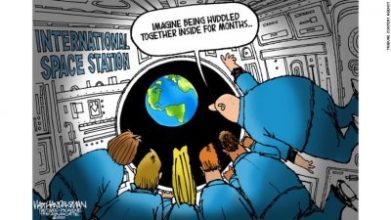
The movies Hidden Figures and The Right Stuff offer related but distinctively different views of the Mercury Space program in the early 1960s. They both tell the story but they are not exactly the same stories. The Right Stuff based on a popular book of the same name focused on the astronauts themselves. The very title of the book and movie has become part of the American culture. The subjects and events of this book and movie tended to be known to the general public with a special shout out to ace pilot Chuck Yeager who did not become an astronaut.
By contrast, Hidden Figures portrays a less known facet of the space program. Its subjects are three women, Katherine G. Johnson, Dorothy Vaughan, and Mary Jackson, who work as “computers,” people who do computing. More importantly they are Negroes or colored people. Black people had not yet become first Afro-Americans, then African Americans, and people of color. These changes in terminology are part of American history.
Like The Right Stuff, Hidden Figures reveals a very American way of life, just a different one. The lives of the three lead characters and the people with whom they engage are stories of family, education, church, and service to country. It is a story of people who embrace the American dream as much as the astronauts in The Right Stuff do. The difference, of course, is the opportunity to live the American Dream. In the movie, one black woman gains access to the previously restricted education system for the graduate credits she needs to qualify for a NASA position. A second black woman learns to master the new IBM mainframe computer which uses keypunch cards. For some people, that computer may seem like something from the Stone Age when dinosaurs roamed the earth. The third black woman, naturally gifted even as a child, calculates critical flight plans. All three succeed without becoming public figures until the movie.
One of my favorite scenes in the movie occurs when an off-screen voice calls out that astronaut John Glenn is in trouble in his mission. Everyone rushes to see a TV set in a storefront window in their rural community. “Everyone” means all the people of the community, black and white, standing together as one. This scene is a marked contrast to the newsreel shots from both movies of people lined up along the beaches in Florida. These views are often distant shots but the overwhelming impression is that the people are white. It turns out black people cared about the American space program too.
Whether or not everyone would even gather today to witness what was occurring live in space or on earth today is more problematical. I think of those stock movie scenes where everyone is shown simultaneously reading the latest issue of local paper with the headlines about the subject of the movie. Now many of those newspapers don’t exist (see Spartacus, Local History, and Local Newspapers) and people tend to look down at their palms holding a device instead. I think of the scenes of the people in the Times Squares of the world watching and cheering as Matt Damon is rescued from Mars and wonder if the world could really gather as one anymore.
Other questions occur. Is the Kevin Costner character real or a Hollywood (composite) creation? I don’t know. He has a lot of good lines and is of almost to-good-to-be true character. My favorite scene follows the one when he learns there are no colored bathrooms in the white complex. That necessitates Katherine Johnson having to go a half-mile, sometimes in the rain, to the colored complex to relieve herself. When she has to explain to Costner why she disappears for so long during the day, she explodes in a tirade. That scene may be great Hollywood, but even if the Costner figure is real, an extended impassioned one-sided tirade by a subordinate, a subordinate female, a subordinate black female seems more Hollywood than real. I could be wrong.
The tirade isn’t my favorite part. It is the scene afterwards where Costner takes a crowbar to “Colored Women” bathroom sign. After knocking it down, he walks away announcing the new NASA policy eliminating the separate and unequal bathrooms (missing paper towels in another scene) by race. He walks away uttering the immortal lines, “At NASA we all pee the same color.” It’s not quite “If you build it, he will come” or “the right stuff,’ but I like it all the same. It reminds me of the scene in To Sir with Love, where Sidney Poitier is cut during a fight and bleeds. One student observing the bleeding teacher says something to the effect of “Did you think he bled ink?” Sometimes you can deliver strong messages with just a few words about body fluids. But did this scene really happen?
Another great scene where I wonder if it is true or not occurs during a briefing. Katherine Johnson impresses on Costner her need to attend the briefing. She is the only female and the only black in the room. The question stumping people is the calculation to determine precisely where the decision has to made for the go-no point of re-entry and where the capsule will splash down so the navy can be in position to recover it. The image of Costner handing Johnson chalk to perform the critical calculation live before an audience of big shots including John Glen is identical Michelangelo’s painting at the Sistine Chapel of the hands of God and Adam. That parallel is not coincidental.

That scene starts a sequence. When the issue of landing coordinates arises in the preparation for Glenn’s flight, Glenn asks Costner to have “the smart one” check the numbers. Johnson has just been reassigned back to the Colored Computer Building and been married, two status changes. Now a white male has to make the run to the Colored Computer Building and not to relieve himself but to have her, the black computer, verify the landing coordinates that the IBM apparently erred on. Both the black female and the white male run back to the white area (why couldn’t the white male run back alone?). Once there, Costner gives Johnson access to the Mission Control Center. As best I recall, there were no females or blacks in the Control Room in The Right Stuff. Both were present and more when Matt Damon was rescued.
So, how much of this is real and how much is Hollywood? I don’t know if any journalist or historian has compared these two movie versions of the specific incident of John Glenn’s flight. It certainly would be interesting to know.
“Who will tell the story” presumes there is one story to tell. In the real world, that often is not the case once one goes beyond some very precise details: yes, John Glenn did orbit earth and his mission was aborted. At that point, people then start making choices about what to include in the story they want to tell and how they will tell it. The coronavirus provides a current example of the challenge of “who will tell the story?” What story will be told and who will tell it?”
A long long time ago back on April 5, I wrote a blog Current Events and Local History on the challenge to history organizations to collect the history of the coronavirus as it was occurring around them.

I did not send this blog to the media or political distribution lists. I noted the efforts of some European museums to gather this information. I reported on the initiative of the Association of Public Historians of New York State (APHNYS) to request that the municipal historians in the state collect such information. These gatherings did not mean simply collating government press releases or clipping articles where local papers still exist, it meant asking people to journal or express in some way, even daily, their experiences during this crisis. I sent this blog to my history lists in New York and New England close to four weeks ago now.
I also sent a revised version of this history blog to the New York State Board of Regents. I received two replies. One a brief thank you. The second was an email not only to me but to Chancellor of the Board, Interim Commissioner of Education/President of the University of the State of New York, and the Deputy Commissioner of Cultural Education among others. In the email, the Regent notes the “request for students to offer journal documentation of their experience living through this pandemic crisis, from their perspective, for history.” The Regent specifically asks these three individuals for suggestions on how to reach out to teachers and students to go about achieving this ends. I don’t know what will come of this effort, but I am sure once students do return to school they will have stories to tell about what they did last summer and spring.
But what about for American as a whole? Who will tell the American story(ies) on the coronavirus? Yes, there will be a White House version touting the great success of America’s greatest President of successfully winning this war and we will be rockin’ by July. Yes there will be a Congressional Commission documenting the complete and total failure of the inept, incompetent, self-centered, ignorant, simpleminded immature child who was the worst President in American history. That’s quite a range of options. We are witnessing the battle to tell the story of the coronavirus in the United States and there is a good chance at least 405 of the country will believe two completely contradictory stories. If you think teaching the Civil War can be challenging imagine the dilemma for teachers and school districts who have to choose between the pond-scum-slime and our Lord and Savior, the Chosen One Blessed Be his Name versions. So the questions for the country isn’t simply who will tell the story but what story(ies) will be told and how will they divide America even more.
THE ROCKIN’ AMERICA COUNTDOWN HAS BEGUN




